How To make a Christmas cactus bloom, ensure it receives the right amount of light, water, and temperature. Also, giving the plant a period of darkness for about 12-14 hours daily for six weeks before blooming can stimulate flower production.
The holiday season is not complete without the vibrant hues of a blooming Christmas cactus. These unique plants, known for their stunning flowers that blossom during the festive season, can be a delightful addition to your home. If you’ve ever wondered how to make your Christmas cactus burst into a riot of colors, you’re in the right place.Providing adequate nutrients and avoiding stressors like drafts or extreme temperatures can also enhance blooming. Overwatering or exposure to direct sunlight can hinder flowering, so it is important to maintain a balanced routine.
By following these tips, you can encourage your Christmas cactus to bloom during the festive season. So, let’s dive into the details of how to care for these popular plants and make them burst with vibrant blooms.
What Is A Christmas Cactus?
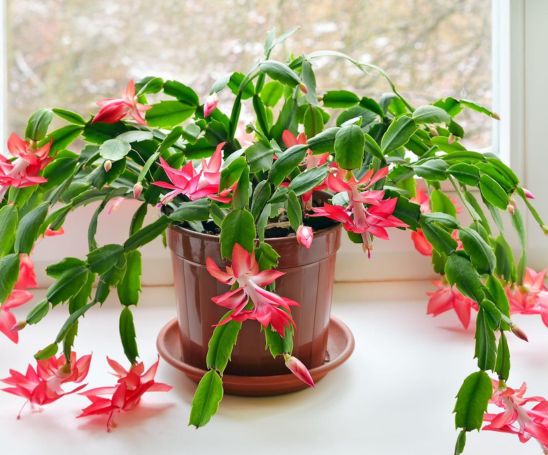
Christmas cacti are easy-care houseplants with fragrant flowers in pink, red, white, and yellow during the holiday season. The plants in this group are epiphytes of South America, clinging to trees and rocks in rainforests to obtain nutrients and rainwater. Featuring flattened, segmented stems that are joined together, this unique cactus looks like a leaf.
Christmas cacti are epiphytes, meaning they grow on trees and rocks rather than on the ground like desert cacti. Its ability to adapt to a range of environments makes it a popular houseplant decor option. The key feature that makes the Christmas cactus so beloved is its ability to produce stunning, vibrant blooms during the holiday season.
Types Of Holiday Cacti
There are different types of holiday cacti, each with its characteristics and blooming times. Among the most common types are the Thanksgiving cactus, the Easter cactus, as well as the Christmas cactus.
Thanksgiving Cactus
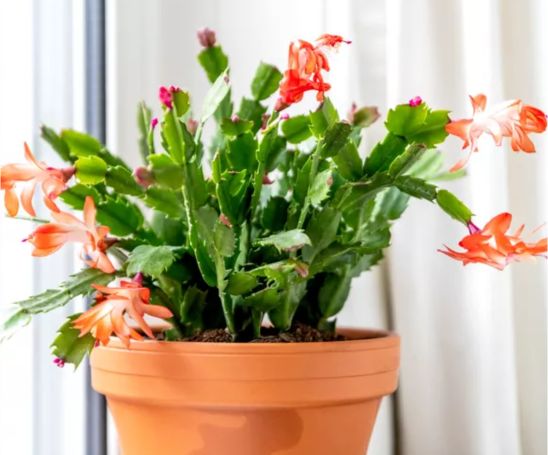
The Thanksgiving cactus, also known as Schlumbergera truncata, is characterized by its pointed teeth along the edges of its stem segments. During the fall, this cactus blooms around Thanksgiving, earning its name.
Its flowers come in various colors, including shades of pink, red, and white. Although it blooms earlier than the Christmas cactus, the care required for both plants is quite similar.
Easter Cactus
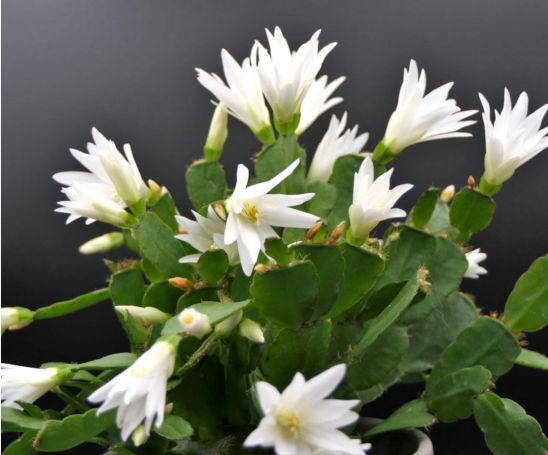
The Easter cactus, known as Hatiora gaertneri, is a close relative of the Christmas and Thanksgiving cacti. This cactus has rounded and scalloped stem segments, which give it a more rounded appearance compared to its counterparts.
As the name suggests, the Easter cactus blooms around the Easter holiday in spring. Its flowers range in color from pink to lavender, adding a delightful touch to any Easter celebration. Understanding the different types of holiday cacti can be valuable for plant enthusiasts.
While they share some similarities, each type has its unique qualities and blooming patterns. By understanding these differences, you can tailor your care routine and expectations, ensuring healthy growth and spectacular blooms.
Now that we’ve explored the different types of holiday cacti, it’s time to dive deeper into the specific care requirements for the Christmas cactus.
How To Make A Christmas Cactus Bloom?

You may also like CACTUS FLOWER BLOOM
To help your Christmas cactus bloom, ensure it gets enough sunlight and darkness, provide proper watering and temperature conditions, and give it a period of rest after blooming. You can also use a specific fertilizer to encourage blooming.
Christmas cacti are beautiful plants that can brighten up any space during the holiday season. However, getting them to bloom can sometimes be a challenge, from understanding when these plants bloom to providing the right care, light, soil, water, temperature, humidity, fertilizer, and pruning techniques.
When Does A Christmas Cactus Bloom?
The blooming of a Christmas cactus depends on its natural cycle, which is influenced by a combination of longer nights and cooler temperatures. These plants usually start blooming in late fall or early winter, around November or December.
However, proper care and specific conditions can encourage your Christmas cactus to bloom earlier, extending its colorful display.
How to get Christmas cactus to bloom?
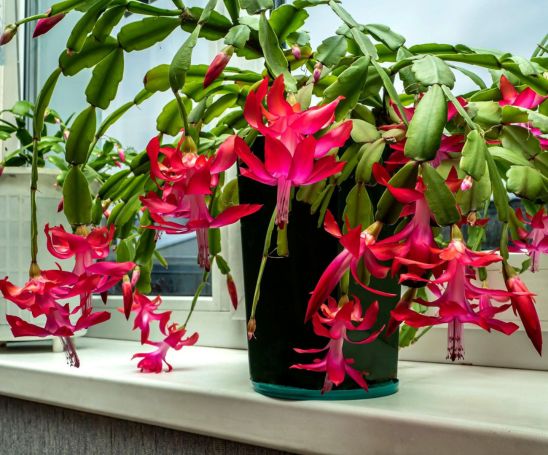
With a few simple tips and tricks, you can encourage your cactus to bloom beautifully. When it comes to caring for your Christmas cactus, it’s essential to understand its specific needs.
Providing the right care will not only ensure plant health but also encourage blooming. The following information will help you:
Light
Proper lighting is crucial for the blooming of a Christmas cactus. Bright, indirect light is preferred, as direct sunlight can cause the plant to scorch. Place your cactus near a window where it can receive bright light for about 12-14 hours a day. Avoid exposing it to artificial light during the night, as this can disrupt its natural blooming cycle.
Soil
Using the right soil is essential for the health and blooming of your Christmas cactus. Choose a well-draining, acidic soil mixture designed for cacti and succulents. The bottom of the pot can also be improved by adding a layer of pebbles or small rocks.
Water
Proper watering is crucial to prevent under or overwatering, both of which can hinder bloom production. Allow the top two inches of soil to dry out before watering your Christmas cactus.
When watering, drench the soil and allow any excess water to drain out completely. Avoid leaving your plant sitting in standing water, as this can lead to root rot.
Temperature And Humidity
Temperature and humidity levels also play a crucial role in the blooming of your Christmas cactus. These plants prefer moderate temperatures and thrive in environments with humidity levels between 50% to 60%. Here are some tips to ensure the right conditions:
Temperature |
Humidity |
| Maintain a temperature range of 60°F to 70°F (15°C to 21°C) during the day. | Keep humidity levels between 50% to 60%. |
| Avoid exposing your Christmas cactus to extreme temperatures or drafts, as this can hinder blooming. | If the air in your home is dry, you can increase humidity levels by placing a tray filled with water near your cactus or using a humidifier. |
Environmental conditions for optimal growth
Fertilizing Your Christmas Cactus For Vibrant Blooms
To promote vibrant blooms, fertilizing your Christmas cactus is essential. Here’s what you need to know:
- Use a balanced fertilizer designed for cacti and succulents.
- Fertilize the Christmas cactus every two to four weeks during spring and summer when it is growing.
- Fertilize twice a month in the fall and winter when plants are dormant.
- Plants can be harmed if they are overfertilized, so follow the fertilizer package instructions.
Pruning And Shaping To Encourage Blooming
To encourage blooming and maintain a healthy shape, pruning and shaping your Christmas cactus is necessary. Here are some tips:
- After the blooming period is over, prune any dead or damaged stems to keep the plant tidy and remove any potential sources of disease.
- Remove a few segments from the tips of the branches to encourage branching and a bushier growth habit.
- To shape your Christmas cactus, prune the rounded edges of the stem segments to create a more compact and pleasing form.
- Pruning can be done throughout the year, but avoid excessive pruning during the blooming period to allow the plant to conserve energy for blooming.
How do you force a Christmas cactus to bloom?
Propagation Tips To Expand Your Christmas Cactus
Here are some propagation tips to help you grow new Christmas cactus plants and boost blooming:
- Choose a healthy segment: Select a mature segment from your existing cactus to propagate. The segment should have 2-3 segments of its own.
- Allow the segment to be insensitive: Place the segment in a warm, dry location and allow it to develop a callous for a few days. This helps prevent rotting during the propagation process.
- Prepare the rooting medium: Mix well-draining soil or cactus potting mix with perlite or sand to create an ideal rooting medium.
- Plant the segment: Make a small hole in the rooting medium and place the segment, ensuring that at least one segment is buried to encourage root development.
- Provide proper care: Place the planted segment in a warm and lit area, but avoid direct sunlight. Keep the soil moist and mist the cactus to provide the necessary humidity.
- Wait for roots to establish: In approximately 4-6 weeks, your propagated segment should develop roots. Once well-established, you can transplant it into a larger pot to continue its growth.
How To Grow Christmas Cactus From Seed?
If you’re up for a little challenge, growing Christmas cactus from seed can be a fun and exciting experiment.
- Start by collecting mature seeds from your existing Christmas cactus. The branches end in small, pod-like structures.
- It is best to use fresh seeds to ensure successful germination. Plant the seeds 24 hours after soaking them in water.
- Prepare a well-draining potting mix and fill a small seed tray or individual pots.
- Sow the seeds on the surface of the soil and press them into the mix. Don’t cover the seeds with soil, as they need light to germinate.
- Mist the surface of the soil with water to keep it moist but not waterlogged.
- Place the tray or pots in a warm, bright location away from direct sunlight.
- Keep the soil moist and expect germination to occur within 2-4 weeks.
- The seedlings can be transplanted into individual pots once they have grown a pair of true leaves.
Repotting Christmas Cactus
If you’re up for a little challenge, growing Christmas cactus from seed can be a fun and exciting experiment.
- Start by collecting mature seeds from your existing Christmas cactus. The branches end in small, pod-like structures.
- It is best to use fresh seeds to ensure successful germination. Plant the seeds 24 hours after soaking them in water.
- Prepare a well-draining potting mix and fill a small seed tray or individual pots.
- Sow the seeds on the surface of the soil and press them into the mix. Please don’t cover the seeds with soil, as they need light to germinate.
- Mist the surface of the soil with water to keep it moist but not waterlogged.
- Place the tray or pots in a warm, bright location away from direct sunlight.
- Keep the soil moist and expect germination to occur within 2-4 weeks.
- The seedlings can be transplanted into individual pots once they have grown a pair of true leaves.
Common Pest Problems With A Christmas Cactus
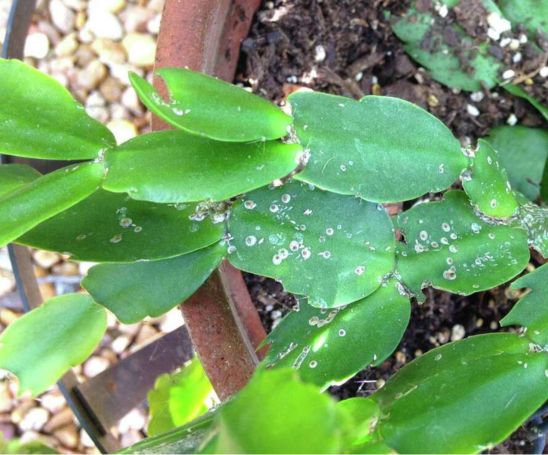
Pests can wreak havoc on your Christmas cactus, hindering its ability to bloom. It is essential to be able to identify and treat any infestations promptly. Common pests that can affect your holiday cactus include:
Spider mites: These tiny insects can leave fine webs on the cactus and cause leaves to yellow and dry out. Treat with insecticidal soap or neem oil.
Mealybugs: These cotton-like bugs settle in the leaf axils and crevices, causing yellowing and stunted growth. Remove with a cotton swab dipped in alcohol or use insecticidal soap.
Aphids: Small, pear-shaped insects that cluster on new growth, causing deformities and leaf curl. Remove them with a strong jet of water or use insecticidal soap.
Scale insects: These oval-shaped, brown insects attach themselves to the stems and leaves, sucking sap and causing yellowing and leaf drop. Remove them or apply insecticidal soap.
Yellowed, Spotted, Or Wilting Leaves Or Stems
If you notice yellowed, spotted, or wilting leaves or stems on your Christmas cactus, it may be a sign of stress or improper care. These issues can impact the plant’s ability to bloom.
Check for signs of pests, such as mealybugs or spider mites. If you spot any, take immediate action to drop them. Ensure your cactus is not exposed to drastic temperature fluctuations, drafts, or cold air. Keep it in a stable environment with temperatures between 60-70°F (15-21°C).
Avoid over or underwatering, as both can lead to stress and damage the plant. Stick to a regular watering schedule and adjust it based on the cactus’s needs and the surrounding environment. Consider repotting your Christmas cactus if you suspect root rot. Look for mushy or blackened roots and replant it in fresh, well-draining soil.
Leaves turning Red Or Pink
If you’ve noticed your Christmas cactus’s leaves turning red or pink, it may be a sign that it’s nearing its blooming stage. This color change is a sign that the plant is getting ready to produce vibrant flowers.
To support your cactus during this stage, keep the following points in mind:
- Make sure your cactus is receiving adequate light, especially bright indirect sunlight. This will help intensify the red or pink coloration of the leaves.
- Keep the watering consistent, ensuring the soil remains moist. However, remember not to overwater, as it can lead to root rot.
- Cut disturbances during the budding and flowering stage. Avoid moving or rotating your plant, as it can disrupt the process.
By following these tips and addressing common problems with your Christmas cactus, you can increase the chances of getting it to bloom. With a little care and patience, your cactus will reward you with a stunning display of festive flowers!
Frequently Asked Questions
Why Is My Christmas Cactus Dropping Leaves?
Christmas cacti may drop leaves due to improper care, but with the right steps, you can make it bloom. Provide it with proper light, water, and temperature conditions, and ensure it goes through a period of darkness for at least 12-14 hours each day to encourage blooming.
Why Is My Christmas Cactus Turning Purple?
While a Christmas cactus is known for its vibrant green color, it can turn purple for a few reasons. Stress and discoloration may be caused by exposure to low temperatures. Another reason could be overwatering, as excessive moisture can cause the plant to develop a purple hue. To ensure the health of your Christmas cactus, it’s essential to address these issues
Why Is My Christmas Cactus Not Flowering?
If your Christmas cactus is not flowering, it could be due to several factors. One common reason is a lack of proper light exposure. Christmas cacti must have bright, indirect light throughout the year, including the dormant period leading up to flowering.
Other possible causes include insufficient darkness during the rest period, overfertilization, or stress from extreme temperatures. Taking the necessary steps to address these factors can help promote blooming in your Christmas cactus.
How Do You Boost A Christmas Cactus?
To boost the growth and health of your Christmas cactus, there are a few essential steps you can take. make sure it is placed in a location that receives bright, indirect light. Avoid direct sunlight, as it can scorch the leaves. ensure that the plant is watered.
Christmas cacti prefer to dry out between watering sessions, so be cautious not to overwater. providing a well-balanced fertilizer during the active growing season can provide the necessary nutrients to keep the plant thriving.
When Should You Put A Christmas Cactus In The Dark?
You should start the period of darkness around eight weeks before you want your Christmas cactus to bloom. This means placing the plant in a dark location for about 12-14 hours a day, with a consistent temperature of around 50-55°F (10-13°C).
By giving your Christmas cactus the required rest and darkness, you’ll increase the likelihood of abundant blossoms during the holiday season.
How Often Can You Force A Christmas Cactus To Bloom?
You can force a Christmas cactus to bloom once a year by giving it 12-14 hours of darkness daily for about 6 weeks.
Will Epsom Salt Help Christmas Cactus Bloom?
Yes, Epsom salt can help the Christmas cactus bloom. It provides magnesium, which promotes flower growth. Mix one tablespoon of Epsom salt with a gallon of water, and water your cactus once a month during the blooming season.
Conclusion
From providing the ideal light conditions to watering and fertilizing at the right times, paying attention to temperature and humidity levels, as well as pruning and propagating when necessary, these steps will help your Christmas cactus thrive and reward you with a stunning display of blossoms.From choosing the right pot and soil to understanding its blooming cycles, each step contributes to a vibrant display. With care and patience, your Christmas cactus becomes a joyful centerpiece for the holiday season.







